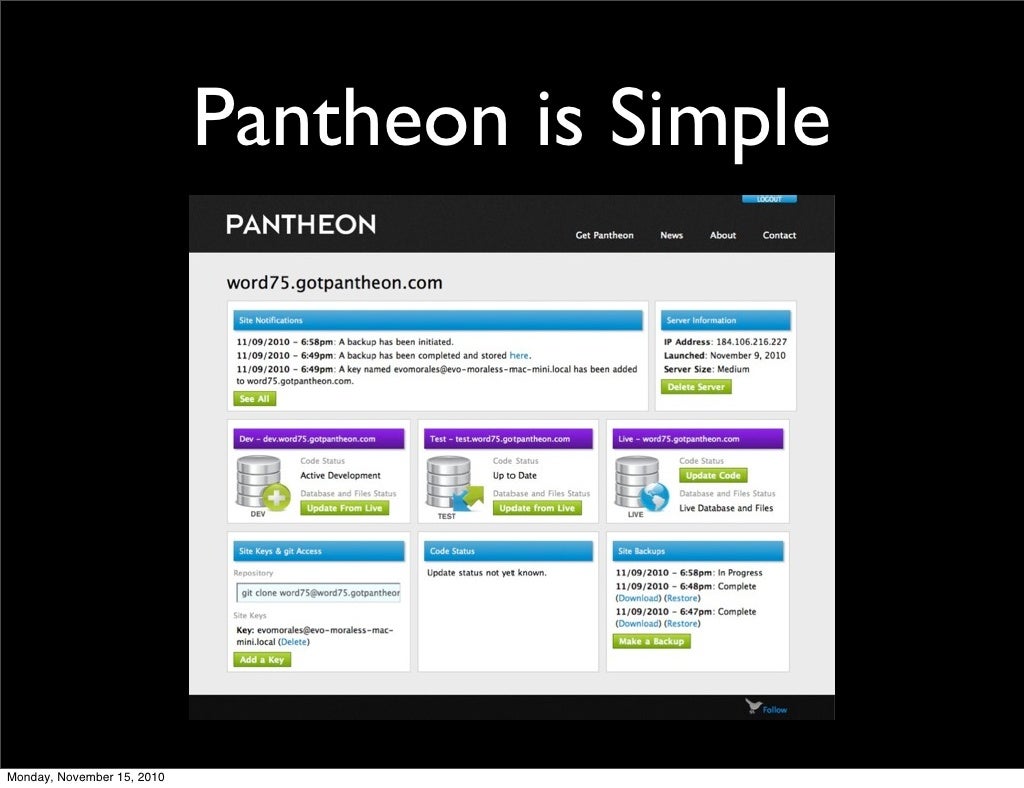

If you speak Terminus, then you'll notice that the command doesn't actually create a new database backup, but rather downloads the most recent. Terminus backup:get $ -element=db -to=db.sql.gz Ls /var/www/html/.ddev >/dev/null # This just refreshes stale NFS if possible # set -x # You can enable bash debugging output by uncommenting

Dive DeeperĪs mentioned earlier, the file doesn't just include the parameters for the provider integration, it also contains the actual commands for each step of the integration.įor example, in the "ddev_pull_command" section, you can see the various bash commands used to obtain a database backup from Pantheon: db_pull_command: ddev/providers/ file in your DDEV project.

This is a summary of the integration steps - for all the details, be sure to check out the. If you don't want to sync the content files to your local, then you can add the "-skip-files" parameter.
#PANTHEON DRUPAL UPDATE#
Once configured, to update your local database and content files, run "ddev pull pantheon" and you’re set. In this example, the machine name of Pantheon project is "de8" and we're going to be updating the local DDEV environment with database and content files backups from the Pantheon Live environment. This allows you to target exactly which site and Pantheon environment you'd like to access the database backup and content files from when running the "ddev pull" command. If you don't, then it's easy to add via: $ ddev composer require drush/drushįor basic integration, you'll just need to copy the provider file to pantheon.yaml and then update the site name and environment variable. The Pantheon integration also requires that you have Drush installed as part of the Drupal project. This allows DDEV to access your Pantheon projects via Terminus (built-in to DDEV), in order to access database and content file backups. The Pantheon integration requires that a Pantheon machine token be created and added to your machine's ~/.ddev/global_config.yaml file in the following format: web_environment: These are not officially supported, so please use them with caution.
#PANTHEON DRUPAL CODE#
Each provider integration includes documentation, as well as the complete code for the integration - making it easy for you to customize.Ī DDEV community member, Matthias Andrasch, has been working on DDEV provider integration for WordPress find them here.
#PANTHEON DRUPAL MANUAL#
For the database, the manual process normally involves downloading a database dump and importing it into the local development environment.ĭDEV's "provider" functionality automates the steps into a single "ddev pull" command that can authenticate with a remote server, download the most recent database backup, and then import it into the local environment - all with just a single command! How Exactly Does It Work?ĭDEV includes sample provider integrations for Drupal (but not WordPress yet) they are located in your DDEV project's. One of the typical challenges that a developer faces when working on their local development environment is keeping their local database and content files up-to-date with a remote environment (development, test, or live). Much like similar Docker-based solutions, DDEV hides most of the complexity of Docker - allowing Drupal and WordPress developers to focus on what they like best. Automating the Process of Keeping Your Local Environment Up-to-dateĭDEV is a Docker-based local development environment solution that allows developers to run local copies of all their Drupal and WordPress projects in a personal development environment. Reposted with permission from Pantheon.io.


 0 kommentar(er)
0 kommentar(er)
